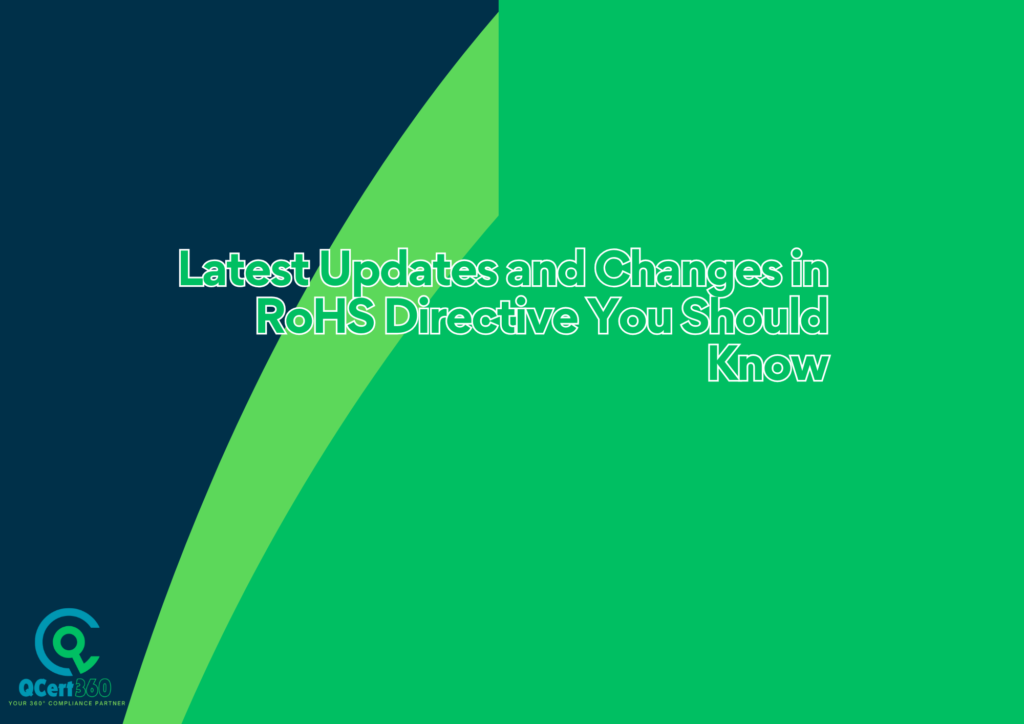Latest Updates and Changes in RoHS Directive You Should Know

In today’s eco-conscious world, regulatory compliance is no longer just a formality—it’s part of your brand’s reputation. For those in the electronics manufacturing or supply business, the RoHS Directive remains a vital piece of that compliance puzzle.
But here’s the catch: RoHS isn’t static. It keeps evolving to reflect changes in technology, science, and global sustainability goals. That’s why keeping up with the RoHS directive updates 2025 is essential—not only to meet legal obligations but to maintain market access and consumer trust.
This blog walks you through the latest RoHS updates, what they mean for your operations, and how to handle compliance without stress.
What is RoHS and Why Does It Matter?
RoHS stands for Restriction of Hazardous Substances. It originated in the European Union in 2003, aiming to limit the use of hazardous materials in electrical and electronic equipment (EEE). The directive’s purpose is simple: protect both human health and the environment from harmful substances used in electronics.
Initially, RoHS restricted six substances—like lead, mercury, and cadmium. However, the directive has grown more rigorous over the years. The update in 2015, often referred to as RoHS 3, added four phthalates to the list: DEHP, BBP, DBP, and DIBP. These plasticizers are commonly found in wire insulation and casings, but they’re now restricted due to health risks.
If you’re producing or distributing electronics in the EU or any market that aligns with RoHS, ignoring these updates is not an option.
RoHS Directive Updates 2025: What’s New?
New Phthalates Restrictions
The most impactful update involves tighter control on the four phthalates mentioned above. Under RoHS, these are now limited to 0.1% concentration in homogeneous materials.
For manufacturers, this means stricter screening of materials—especially plastics. If your business deals with wires, cables, enclosures, or coated components, this change directly affects you. Following a RoHS phthalates compliance guide is crucial to avoid costly rework, recalls, or blocked market access.
RoHS Exemption Latest List: What’s Still Allowed?
Not all applications can avoid hazardous substances—especially in medical, military, or high-temperature environments. That’s why the RoHS exemption latest list exists. This list outlines substances or applications temporarily excluded from the restrictions.
The exemption list is reviewed regularly, and changes may affect whether your products need new testing or documentation. Checking the latest list annually helps you stay compliant without unnecessary costs or disruptions.
Enhanced Documentation Requirements
Authorities now expect deeper transparency. Complying with RoHS documentation best practices means creating and maintaining detailed technical files that include:
- Product descriptions
- Materials data
- Test reports
- Supplier declarations
- Conformity assessments
This documentation is essential not just for audits but for quick product clearance in competitive markets. Being proactive can prevent delays or legal penalties.
Why Supply Chain Transparency Is Important
In today’s global supply chains, knowing every detail about your product’s components can be tricky. That’s where RoHS supply chain transparency tools come in.
These digital solutions help track material data from raw suppliers to finished products. With features like automated supplier data collection, digital certificates, and compliance dashboards, these tools:
- Reduce manual work
- Minimize non-compliance risks
- Make audits less stressful
- Improve collaboration with suppliers
If you’ve ever found yourself Googling “RoHS testing labs near me”, you probably already know how complex material verification can get. These tools make that job easier.
Your RoHS Compliance Checklist for Electronics
A strong RoHS compliance checklist for electronics keeps your team aligned and your risks low. Here’s a solid framework you can adapt:
- Determine RoHS Scope: Know which of your products fall under RoHS requirements.
- Review Materials: Identify any restricted substances in components or casings.
- Check Exemptions: See if any current exemptions apply to your use case.
- Supplier Documentation: Collect declarations of conformity and testing results.
- Technical File Preparation: Organize your product’s documentation for audit-readiness.
- Conduct Internal Audits: Regularly evaluate your processes.
- Prepare for Certification: Work with a certification body if needed for market access.
Having this checklist in place helps streamline both new product development and existing product updates.
RoHS Certification Process Simplified
Many businesses hesitate at the idea of RoHS certification because it seems complex. The truth is, it’s manageable when broken into clear steps:
- Gap Analysis – Where are you now vs. where you need to be?
- Testing – Get materials and components tested in accredited labs.
- Documentation – Build out technical files and supplier records.
- Internal Audit – Fix any gaps internally before external scrutiny.
- External Review – Work with certification experts or auditors to verify compliance.
That’s your RoHS certification process simplified in five steps. With good planning and expert help, it becomes far less intimidating.
RoHS Compliance Cost Factors to Consider
Compliance isn’t free, but understanding where costs come from helps you plan better. The RoHS compliance cost depends on several factors:
- Number of product variants
- The complexity of your supply chain & the product
- Frequency of product updates
- Use of testing labs or software tools
- Need for RoHS consultancy services in your specific location or globally
For companies with many SKUs, automation tools or external consultants can be a cost-effective investment, saving both time and rework.
Proactive Tips to Stay Ahead
Want to go beyond just meeting RoHS requirements? Here’s how you can lead the way:
✅ Stay Informed
Subscribe to EU regulatory updates, follow tech and compliance blogs, or join industry forums.
📢 Train Internally
Make RoHS part of onboarding and ongoing training, especially for teams in engineering, procurement, and quality assurance.
🤝 Strengthen Supplier Relations
Don’t just demand declarations—educate and collaborate with your suppliers to improve accuracy and trust.
📅 Plan for Recertification
Products evolve, so schedule annual reviews, especially when adding new components.
💡 Invest in Smart Tools
Digital platforms for RoHS tracking, alerts, and documentation save time and help you scale compliance efforts easily.
By following these habits, you’ll build a resilient RoHS program that adjusts as regulations shift.
How QCert360 Can Help You Navigate RoHS with Confidence
Let’s face it: RoHS compliance can be overwhelming—especially with evolving rules, technical paperwork, and pressure from clients or regulators.
That’s where QCert360 steps in.
We offer end-to-end RoHS consultancy services, tailored to your business needs. Whether it’s your first time going through the process or you’re updating your systems for the RoHS directive updates 2025, our experts can assist with:
- Initial gap analysis & product inspection
- Material testing coordination
- Supplier communication templates
- Training for in-house teams
- Full RoHS documentation support
- Audit preparation with notified bodies
With QCert360 by your side, RoHS compliance becomes less of a burden and more of a strategic advantage.
Final Thoughts
Navigating RoHS compliance isn’t just about avoiding fines—it’s about building safer, more responsible products. With constant changes like the RoHS directive updates 2025, the key is staying proactive, organized, and informed.
Leverage tools like RoHS supply chain transparency platforms, follow a robust RoHS compliance checklist for electronics, and don’t hesitate to seek expert support when things get complicated.
Let QCert360 be your trusted partner to ensure you’re always one step ahead in compliance—without slowing down your innovation or growth.
Get in Touch with QCert360
📞 Call us: +91 7483870406
📧 Email: contact@qcert360.com
🌐 Website: www.qcert360.com


